
39 minute read
OF COATING FILM THICKNESS ON THE QUALITY OF SURFACE FINISH ON LIGHTWEIGHT PLYWOOD
ACTA FACULTATIS XYLOLOGIAE ZVOLEN, 64(1): 39−58, 2022 Zvolen, Technická univerzita vo Zvolene DOI: 10.17423/afx.2022.64.1.04
Advertisement
Gabriela Slabejová – Mária Šmidriaková
ABSTRACT
The paper deals with the effect of the coating film thickness of various types of coating material on the quality of surface finish on lightweight plywood. Three surface finishes (solvent-based, water-based and hard wax) were formed of coating materials on the lightweight plywood sheathed with pressed beech veneer. The coating materials were applied in one, two and three layers. The surface finished samples were exposed to simulated light radiation in the Q-SUN test. Several optical surface properties (gloss value, colour difference, surface roughness) and resistance surface properties (impact resistance, abrasion resistance) were investigated. The optical properties of all surface finishes were very much allied to the type of coating material and the coating film thickness. As the coating film thickness (i.e., the number of coats) increased, the gloss increased as well. Evaluated dependences of gloss value and of colour difference on the coating film thickness showed a high degree of dependence on the Solvent-based and Water-based surface finishes. For the Hard wax surface finish, the evaluated dependence of gloss value on the coating film thickness showed a very high degree of dependence. The surface roughness was very much allied to the type of coating material and the wood fibre direction. The lowest surface roughness of the surface with three layers was noticed on hard wax. The mechanical resistance properties of all surface finishes were very much allied to the type of coating material and the coating film thickness. Evaluated dependence of impact resistance on the coating film thickness showed a very high degree of dependence on the Solvent-based and Water-based surface finishes, and a high degree of dependence on the Hard wax surface finish. The highest resistance to abrasion and the highest impact resistance was measured on the hard wax surface finish. Key words: beech veneer, lightweight plywood, coating material, gloss value, colour difference, surface roughness, impact resistance, abrasion resistance
INTRODUCTION
To achieve better dimensional stability and to improve mechanical properties of woodbased construction material, the composite materials are produced. The composite materials are materials of large-scale dimensions, characterized by steadiness of mechanical properties, and greater resistance to the environment (KRÁL and HRÁZSKÝ,2005). Currently, in practice, the composite materials having a layer of veneer and a layer of veneer with spaces of air (e.g., lightweight plywood) are used. Variously modified veneers can be used to make plywood. Various heat-treated veneers were dealt by HSU et al.(2021), and BEKHTA
39
et al. (2016), the plywood panels manufactured from combinations of thermally densified and non-densified veneers were dealt by BEKHTA et al. (2020). The effect of veneer densification temperature and wood species on the plywood properties were dealt by SALCA et al. (2020). The formability of veneers was mentioned byFEKIAČ et al. (2020), FEKIAČ and GÁBORÍK (2018), FEKIAČ et al. (2015), ZEMIAR et al. (2014), LANGOVÁ and JOŠČÁK (2014), and SLABEJOVÁ and ŠMIDRIAKOVÁ (2014). Just like the surface of native wood, the surface of lightweight plywood must be finished. The quality of the surface finish is determined by the surface properties of substrate in interaction with the properties of coating film. In the case of lightweight plywood, the quality of surface finish is influenced by surface morphology of the veneer used for sheathing in the production of lightweight plywood. Wood surface morphology needs to be assessed by quantifying roughness (LUO et al. 2020, KÚDELA et al. 2018, LAINA et al. 2017, GÁBORÍK et al. 2017, GURAU and IRLE 2017, KÚDELA et al. 2016a, GURAU 2013). GURAU and IRLE (2017) state that the surface roughness can have a huge impact on finishing costs and the perceived quality of wood products; there is a lack of consensus on how to measure and evaluate wood surface roughness. Hardness was found to be the property of the wood that most clearly affects its final roughness and makes it difficult to achieve better roughness results as the hardness increases (LAINA et al. 2017). Colour and gloss are important appearance properties of wood, and they change due to various factors. The surface gloss was monitored on wood plastic composites (YANG et al. 2020). ŞENOL and BUDAKÇI (2019) determined the gloss and hardness values of lowdensity wood materials.
The change in colour of wood surface after applying a transparent coating material is an interaction of colour of the coating film with the colour of wood surface. Various transparent finishes cause different colour of wood surface (SLABEJOVÁ and ŠMIDRIAKOVÁ 2020, SLABEJOVÁ and ŠMIDRIAKOVÁ 2021). At the same time, the colour of the finished wood surface changes due to sunlight in interior and weathering in exterior (GURLEYEN 2021,VIDHOLDOVÁ andSLABEJOVÁ 2021,KÚDELA et al. 2020, KRŽIŠNIK et al. 2018, GARAY et al. 2017, KÚDELA et al. 2016b).
On coatings, the gloss and colour changes correlate with a slight modification of filmformer substance (GURLEYEN 2021, BEKHTA et al. 2018, CHANG et al. 2019, SCRINZI et al. 2011). Modification of the coating material does not only affect colour and gloss, but also physical-mechanical properties and chemical-resistance properties.
CHANG et al. (2019) state that modification of the coating material does affect the hardness, mass retention, Tg, tensile strength, abrasion resistance, lightfastness, the bending resistance, elongation at break, impact resistance; they increased.
The hardness of wood affects not only the surface roughness, but also the resistance to mechanical stress. The resistance of wood to mechanical stress is increased by surface finish (PAVLIČ et al. 2021). In work CHEUMANI YONA et al. (2021) is presented that coating properties such as scratch and impact resistance were also determined by various silicatebased formulations applied to a beech wood substrate (Fagus sylvatica L.). The mechanical properties of surface finish were researched on veneers modified by silicone resins (SLABEJOVÁ et al. 2018) and on pigmented surface finishes for interior use (SLABEJOVÁ and
ŠMIDRIAKOVÁ 2018).
The aim of this study was to determine the effect of various types of coating material and of the coating film thickness on the quality of surface finish on the lightweight plywood sheathed with pressed beech veneer. The gloss value, colour difference, surface roughness, impact resistance, and abrasion resistance of the surface finishes were assessed.
40
MATERIALS AND METHODS
In experiments, beech wood (Fagus sylvatica L.) veneer was used for production of a lightweight plywood. The cut veneer used for sheathing was pressed in a press with two heated plates. The pressing mode was as follows: pressing temperature 150 °C, pressing time 2 minutes, and compression of 30%. After 24 hours of conditioning (at room temperature of 23 ± 2 °C, relative humidity of 60 ± 5%), the pressed veneer was used to sheath the lightweight plywood. Lightweight plywood was cold pressed, using the mode described in FEKIAČ et al. (2022). The structure of the lightweight plywood with a surface finish is shown in Fig.1.
Fig. 1 Construction of the lightweight plywood; L – pressed solid veneers (longitudinal) forming the sheathing, i.e. the fibers are in the direction of longer dimension of the board; P – veneer strips with width Wp = 160 mm (transverse veneer), i.e. the fibers are perpendicular to the fibers of solid veneer; AG – air gap; Wag – width of the air gap (100 mm); ol – overlap of the layers (30 mm), i.e. places where the veneers are joined. (Note: T1 – one layer, T2 – two layers and T3 – three layers of coating material).
Before testing, the test specimens were conditioned at a room temperature of 23 ± 2 °C and relative humidity of 60 ± 5 % for 28 days. Then the surface of the test pieces was finished (Table 1). Representative types of transparent coating materials were used for surface finishing of the lightweight plywood. The selected coating materials were:
• PUR-Strong 26303 ff – High quality solvent-based 2-component polyurethane clear coat with combination of special UV filters with very high protection against the light. Clear coat is for furniture and interior finishing for industrial and professional use. Very good mechanical and chemical resistance especially for high-wear interior surfaces, high body, good intensification, excellent resistance to yellowing. For highbody varnishing of heavily stressed surfaces in the fitting out of furniture and interiors, for stair steps, for hotel and school equipment, for kitchen and sanitary-area furniture. For highly non-flammable or flame-retardant structures. • Aqua-Step Professional 30153 ff – transparent water-based coating material with a
UV filter with very high protection against the light. This type of coating material can be used as a single component material or if a hardener is added as twocomponent material. As hardener, the solution of aliphatic polyisocyanate is used. • Naturnah Hartwachs 96050 – hard wax, free of solvents, based on native oils and wax. It contains linseed oil, bees wax, carnauba wax, and cobalt-zircon siccative.
After application, the result is dirt poof and water-resistant surface. Good scratch resistance and resistance to many household chemicals. The curing of the wax layer is done with the help of atmospheric oxygen.
41
The coating materials were applied as recommended in the technical data sheets on lightweight plywood in one (T1), two (T2) and three (T3) layers. Between the individual coats, the surface was sanded with sandpaper listed in Table 1.
Tab. 1 Characteristics of surface finish products and their application in the experiment. Finish product Solvent-based (S-B) Water-based
(W-B) Hard wax (H-W)
Commercial name PUR-Strong 26303 ff Aqua-Step Professional 30153 ff Naturnah Hartwachs 96050
Components
Film former
Based
Twocomponents One/Twocomponent One-component
Polyacrylate resin / Cellulose acetobutyrate Hardener Polyisocyanate Polyurethaneacrylatepolymerdispersion Hardener Aliphatic polyisocyanate
Flaxseed oil, beeswax, carnauba wax, cobalt zirconium desiccant
Solvent Water Free
Gloss Matt Matt Matt
Spread rate (g·m−2) Substrate requirements: - Moisture content (%) 100 100
20 Clear, dry, free of dust, grease, and loose substances 8 - 12
Intermediate sanding (Sand grit) P 280 P 280 P 320
Temperature of the material, air and substrate (°C) 18 – 25
Temperature of the coating material (°C) Max 30 Min 15 Note: Finishes were supplied by Adler Company in Slovakia 80
Coating film thickness
Before testing the specimens, the film thickness was measured using the PosiTector 200. Ten measurements were performed on each surface finish.
Simulated light radiation
The surface finished samples were exposed to simulated light radiation in the Q-SUN test model Xe-1-S, with the following parameters: xenon lamp 1800 W, UV filters: 1 × day light-Q1 × window-Q1, power 0.15 W.m-2, temperature on the black panel 40 ± 2 °C.
The methodology of testing the resistance of surface finishes and of wood surfaces against artificial radiation were according to the standards STN EN ISO 16474-1 and STN EN ISO 16474-2.
Gloss and colour analyses
The surface gloss and colour were measured using the spectrophotometer SPECTRO – GUIDE (Geretsried, Germany). The device was set to an observation angle of 45°/0°, d/8 geometry, D65 light source and gloss 60°. The surface gloss and colour parameters (CIELab parameters) of the tested samples were measured for each sample before and during the ageing in the longitudinal direction. The surface gloss was measured according to the standard EN ISO 2813: 2001-10 (2014). The changes in gloss ΔGU and colour ΔE* of the surfaces of the samples were monitored during 24, 48, 72 and 96 hours in 10 given positions of each sample. The changes in gloss ΔGU were calculated according to the formula 1:
42
∆����=������ − ������ (1)
Where: the index “0” means average values gloss “before” (surface finishing or ageing test = exposure time 0 day), index “1” means average values representing the gloss “after” (surface finishing or ageing test = exposure time 24, 48, 72 and 96 hours).
The CIELab parameters, lightness L*, coordinates a* and b*. Differences between two stimuli were calculated as follows (according to the standard ISO 7724-3): ∆��∗ =���� ∗ − ���� ∗ , (2)
∆��∗ =���� ∗ − ���� ∗ , (3)
∆��∗ =���� ∗ − ���� ∗ , (4)
Where: the index “0” means average values representing the colour coordinate “before” (surface finishing or ageing test = exposure time 0 day), index “1” means average values representing the colour coordinate “after” (surface finishing or ageing test = exposure time 24, 48, 72 and 96 hours). Values of L*, a* and b* were used for calculation of the total colour difference ∆E* according to the Eq. 5:
*E =
2* L + a
2* *2b (5)
The total colour difference ΔE* can be classified according to the grading rules reported in Table 2.
Tab. 2 Colorimetric evaluation (CIVIDINI et al. 2007).
0.2 > ΔE* Not visible difference 0.2 < ΔE* < 2 2 < ΔE* < 3 3 < ΔE* < 6 6 < ΔE* < 12
ΔE* > 12 Small difference Colour difference visible with high quality screen Colour difference visible with medium quality screen High colour difference Different colours
Surface roughness
Surface roughness prior to surface finishing and after application of a paint coat was measured with a contact profilometer POCKET SURF with an irregularity sensor radius r of 0.005 mm. A standard arithmetic deviation of the assessed profile - Ra [μm] was measured.
Each sample was measured 10 times along and 10 times across wood fibres direction in defined points distributed over a measuring distance of 5 × 0.8mm. Measured values were automatically recorded in a computer using a software ROUGHNESS and analysed by the mathematical – statistical software STATISTICA.
Impact resistance
The impact resistance of the surface finishes was determined according to the standard STN EN ISO 6272-2. The intrusion (a pinhole diameter) was measured 5 times on four test specimens and the surface finish was evaluated subjectively according to Table 3.
Tab. 3 Impact resistance: degree and evaluation.
Degree Visual evaluation
1 No visible changes 2 No crack on the surface and the intrusion was only slightly visible 3 Visible light cracks on the surface, typically one to two circular cracks around the intrusion 4 Visible large cracks at the intrusion 5 Visible cracks were also off—site of intrusion, peeling of the coating
43
After each test, the impact resistance was evaluated visually using a stereomicroscope LEICA MZ 9.5 with magnification of 17 ×.
Abrasion resistance
Evaluation of the surface finish resistance to abrasion was determined according to the standard STN EN ISO 7784-3 using three test specimens. The coefficient of the resistance to abrasion KT was calculated according to the formula 6: KT = (m1 – m2)/F (6) where: m1 – specimen weight before sanding (g), m2 – specimen weight after sanding (g), F – correction coefficient of the used pair of abrasive papers (F = 1.052).
Statistical evaluation
The statistical software STATISTICA 12 and MS EXCEL was used to analyse the gathered data: total colour difference (∆E*) and the measured values of surface gloss (GU) and roughness (Ra). The descriptive statistics deal with the basic statistical characteristics of the studied properties—the arithmetic mean and standard deviation. Analysis of variance and simple linear correlation analysis together with the coefficient of determination (Table 4) was used as a method of inductive statistics to evaluate the measured data.
Tab. 4 The coefficient of determination R2 .
R2 ˂ 0.1 0.1 ≤ R2 ˂0.25 0.25 ≤ R2 ˂ 0.5 0.5 ≤ R2 ˂ 0.8 0.8 ≤ R2 ˂ 1
Low degree of dependence Slight degree of dependence Significant degree of dependence High degree of dependence Very high degree of dependence
RESULTS AND DISCUSSION
Coating film thickness
The measured thickness of the coating film is given in Table 5. The single-coat films reached a film thickness in the range from 40.7 μm to 47.9 μm, the films of two coats from 51.7 μm to 70.6 μm, and the films of three coats from 77.3 μm to 93.8 μm.
Tab. 5 The coating film thickness.
Finish product Solvent-based Water-based Hard wax
Number of layers T1 T2 T3 T1 T2 T3 T1 T2 T3
Coating film thickness [μm] 47.2 70.6 93.8 47.9 62.4 87.6 40.7 51.7 77.3
Standard deviation 2.4 2.6 3.9 2.1 2.7 2.8 1.7 2.4 3.8
Gloss and colour analyses
Statistical evaluation of the impact of individual factors and their interactions (Time of light radiation and Finish products, Time of light radiation and Number of layers, Finish products and Number of layers) on the Surface gloss (GU) of lightweight plywood after the surface finishing is shown in Table 6.
44
Table 6 shows that the impact of two factors (Finish products and Number of layers) was statistically highly significant. Among two-factor interactions, only one interaction (Finish products – Number of layers) was statistically highly significant.
Tab. 6 Analysis of variance for surface gloss (GU).
Factors Sum of Squares Degrees
of Freedom Variance F-test Level of Significance p*
Absolute Member 21423.4 1 21423.4 30701.32 0.000000
Time of light radiation (TLR) 2.69 3 0.9 1.28 0.279237
Finish products (FP) 1879.9 2 939.95 1347.02 0.000000
Number of layers (NL) 1635.77 2 817.88 1172.09 0.000000 TLR * FP 5.13 6 0.86 1.23 0.290485 TLR * NL 1.35 6 0.23 0.32 0.924966 FP * NL 641.99 4 160.5 230 0.000000
TLR * FP * NL 3.1 12 0.26 0.37 0.973726 Error 502.42 720 0.7 - Note: p* < 0.001 statistically highly significant; p* > 0.05 statistically insignificant
Table 7 shows the values of the gloss in the longitudinal direction for both native wood surface and the matte surface finishes. The surface finishes showed slightly higher gloss values than the native surface. The highest gloss values were achieved by Water-based surface finish with three coats (Table 7). From the viewpoint of increasing number of coats, the gloss increased on all surface finishes.
Tab. 7 The surface gloss (GU).
Finish product Number of layers Monitored during (hour) 0 24 48 72 96 Surface gloss GU (Standard deviation)
Native -
1.8 (0.47)
Solvent-based
T1 3.2 (0.45) T2 5.35 (0.51) T3 8.5 (0.53) T1 4.75 (0.58)
Water-based
T2 5.7 (0.65) T3 9.1 0.57
Hard wax
T1 1.85 (0.50) T2 2.95 (0.57) T3 3.35 (0.65)
1.8 (0.51) 3.1 (0.57) 5.3 (0.55) 8.2 (0.59) 4.7 (0.65) 5.75 (0.59) 8.45 (0.58) 1.80 (0.49) 3.05 (0.54) 3.40 (0.63)
1.9 (0.54) 3.2 (0.53) 5.35 (0.57) 9.55 (0.57) 4.7 (0.64) 5.85 (0.68) 8.7 (0.55) 1.80 (0.59) 2.90 (0.62) 3.45 (0.58)
1.9 (0.55) 3.25 (0.55) 5.5 (0.50) 8.5 (0.62) 4.8 (0.71) 5.95 (0.58) 8.85 (0.59) 1.85 (0.63) 3.00 (0.68) 3.40 (0.71)
1.9 (0,56) 3.3 (0.48) 5.4 (0.58) 8.55 (0.55) 4.75 (0.62) 5.9 (0.65) 8.5 (0.67) 1.80 (0.55) 2.95 (0.59) 3.45 (0.73)
The graphs in Fig. 2a-c. show dependence of ∆GU on the coating film thickness after 96 hours. The evaluation was done using correlation analyse and the coefficient of determination R2. For Water-based surface finish, the dependence of ∆GU on the coating
45
film thickness showed “High degree of dependence” (Fig. 2b). This hypothesis was also confirmed by GURLEYEN (2021) and BEKHTA et al. (2018). This may be due to thick varnish layers completely filling the wood pores and changes in optical properties (BUDAKCI 1997). By effect of xenon light in the Sun-Q test, the gloss of the native wood increased slightly after 48 hours and remained the same after 96 hours. There were only slight changes in gloss on the surface finishes up to 96 hours. GURLEYEN (2021) states that the gloss of finishes decreases with prolonged exposure to light in the accelerated test.
On Solvent-based surface finish, a slight decrease in gloss was observed after 24 hours and a slight increase after 48 hours to 96 hours. For Solvent-based surface finish, the dependence of ∆GU on the coating film thickness showed “High degree of dependence” (Fig. 2a). Due to xenon light, the gloss on Hard-wax surface finish with three coats slightly increased. For Hard-wax surface finish, the dependence of ∆GU on the coating film thickness showed “Very high degree of dependence” (Fig. 2c).
Statistical evaluation of the impact of individual factors and their interactions (Time of light radiation and Finish products, Time of light radiation and Number of layers, Finish products and Number of layers) on the colour difference (ΔE*) of lightweight plywood after the surface finishing is shown in Table 8.
Table 8 shows, that the impact of three factors (Time of light radiation, Finish products, Number of layers) was statistically highly significant. Among two-factor interactions, only two interactions (Time of light radiation – Number of layers, Finish products – Number of layers) were statistically highly significant. Three-factor interaction (Time of light radiation – Finish products – Number of layers) was statistically highly significant.
Tab. 8 Analysis of variance for colour difference (ΔE*).
Factors Sum of Squares Degrees
of Freedom Variance F-test Level of Significance p*
Absolute Member 7539.78 1 7539.78 2535.49 0.000000
Time of light radiation (TLR) 3672.09 3 1224.03 411.62 0.000000
Finish products (FP) 101.33 2 50.67 17.04 0.000000
Number of layers (NL) 105.52 2 52.76 17.74 0.000000 TLR * FP 57.07 6 9.51 3.2 0.004169 TLR * NL 130.12 6 21.69 7.29 0.000000 FP * NL 125.87 4 31.47 10.58 0.000000
TLR * FP * NL 132.54 12 11.05 3.71 0.000018 Error 2141.07 720 2.97 Note: p* < 0.001 statistically high significant; p* > 0.05 statistically insignificant
Table 9 summarises the colour parameters (L*, a*, b*) of native wood (original) and the surface finishes before exposition to simulated light radiation in the Q-SUN test and also the change of the colour parameters (∆L*, ∆a*, ∆b*) and the total colour difference ΔE* after the samples were exposed to simulated light radiation (monitored during 24, 48, 72 and 96 hours).
The differences in the lightness ∆L* were always negative; the surfaces darkened on both the surface finishes and the native beechwood. Positive changes ∆a* were on all surface finishes for all thickness of the coating films. The a* coordinate was in the red area and, after exposed to simulated light radiation in the Q-SUN test, it was even more pronounced towards the red. Positive changes in ∆b* were apparent on the Solvent-based and Waterbased surface finishes. The b* coordinate, after exposition of the samples to simulated light
46
radiation in the Q-SUN test,was more pronounced towards the yellow. The negative changes in ∆b* were apparent on the Wax-Oil surface finish.
In the studies by GURLEYEN et al. (2019) and AYATA et al. (2017), polyacrylic-based resin-coated wood showed a slightly lower decrease in lightness. There was a slight increase followed by a decrease in redness (lower a*) and a clear decrease in the yellow tone (b*).
Tab. 9 The chromatic parameters and colour difference.
Finish product Number of layers Chromatic Parameter
Monitored during (hour) (Standard deviation) 0 Difference 24 48 72 96
Native
based Solvent
based Water -
Hard wax T1
T2
T3
T1
T2
T3
T1
T2
T3
L* 79.52 (0.49) ΔL* -2.14 -3.58 -4.34 -5.09 a* 7.33 (0.21) Δa* 1.24 1.79 2.48 2.94 b* 14.93 (0.31) Δb* 0.48 1.03 2.28 2.74 ΔE* 2.52 4.13 5.49 6.49 L* 75.81 (0.51) ΔL* -1.24 -2.19 -2.98 -3.89 a* 11.63 (0.17) Δa* 1.02 1.38 1.98 2.61 b* 20.24 (0.23) Δb* 0.32 0.68 1.09 1.28 ΔE* 1.64 2.68 3.74 4.86 L* 74.29 (0.45) ΔL* -1.74 -3.02 -3.98 -5.08 a* 11.54 (0.15) Δa* 1.08 1.69 2.57 2.79 b* 20.81 (0.21) Δb* 0.37 0.71 1.18 1.44 ΔE* 2.08 3.53 4.88 5.97 L* 73.72 (0.38) ΔL* -2.04 -3.28 -4.63 -5.69 a* 11.87 (0.14) Δa* 1.12 1.85 2.15 2.84 b* 21.13 (0.19) Δb* 0.41 0.94 1.17 1.44 ΔE* 2.36 3.88 5.24 6.52 L* 74.85 (1.01) ΔL* -2.0 -2.38 -2.45 -2.57 a* 8.93 (0.48) Δa* 1.12 1.29 1.32 1.46 b* 19.66 (0.49) Δb* 0.48 0.76 0.83 0.91 ΔE* 2.34 2.81 2.90 3.09 L* 73.76 (0.96) ΔL* -2.45 -4.13 -5.12 -6.50 a* 9.24 (0.52) Δa* 1.51 2.27 2.82 3.37 b* 20.08 (0.45) Δb* 0.88 1.70 2.28 2.71 ΔE* 3.00 5.01 6.27 7.81 L* 73.11 (1.08) ΔL* -3.12 -5.24 -7.14 -7.32 a* 10.02 (0.44) Δa* 1.86 2.18 2.95 3.04 b* 20.84 (0.43) Δb* 0.93 1.16 1.88 1.87 ΔE* 3.75 5.79 7.95 8.14 L* 70.62 (1.16) ΔL* -2.44 -2.03 -2.05 -1.86 a* 10.67 (0.36) Δa* 1.43 1.51 1.53 1.39 b* 23.89 (0.21) Δb* -1.29 -0.69 -0.28 0.02 ΔE* 3.10 2.62 2.57 2.32 L* 68.34 (1.02) ΔL* -2.51 -2.54 -2.58 -2.50 a* 11.07 (0.31) Δa* 1.25 1.27 1.29 1.22 b* 24.12 (0.17) Δb* -1.16 -1.14 -0.76 0.04 ΔE* 3.03 3.06 2.98 2.78 L* 66.45 (0.87) ΔL* -2.74 -2.68 -2.05 -1.72 a* 11.82 (0.29) Δa* 1.21 1.25 1.27 1.29 b* 24.94 (0.19) Δb* -1.06 -0.84 -0.45 0.18 ΔE* 3.18 3.07 2.49 2.16
47
The colour difference increases with increasing light exposure time in the SUN-Q test on the Solvent-based and Water-based surface finishes. Interestingly, the colour difference on the Hard wax surface finish decreased with increasing exposure time in the SUN-Q test. SLABEJOVÁ and ŠMIDRIAKOVÁ (2021) state the decrease of colour difference for Wax-Oil surface finish on beech wood after 10 days of exposure to natural light.
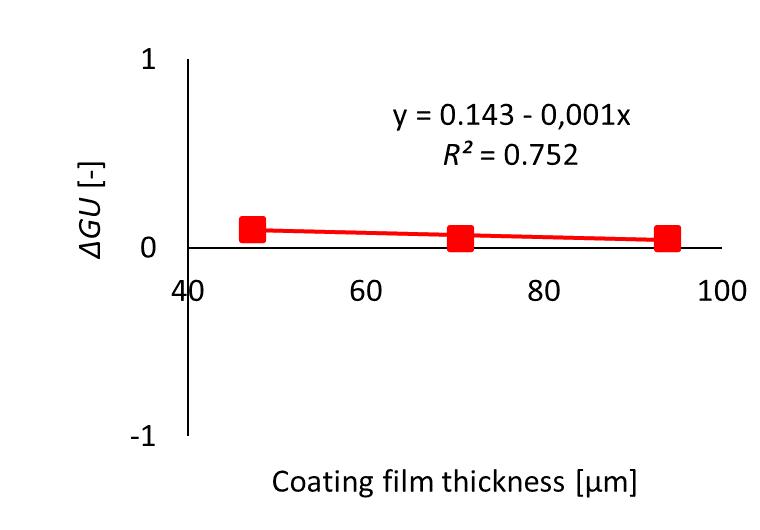
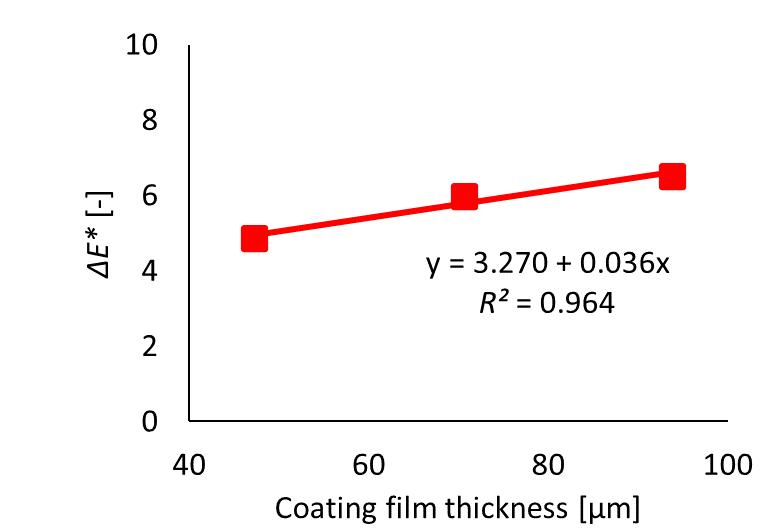
a) d)
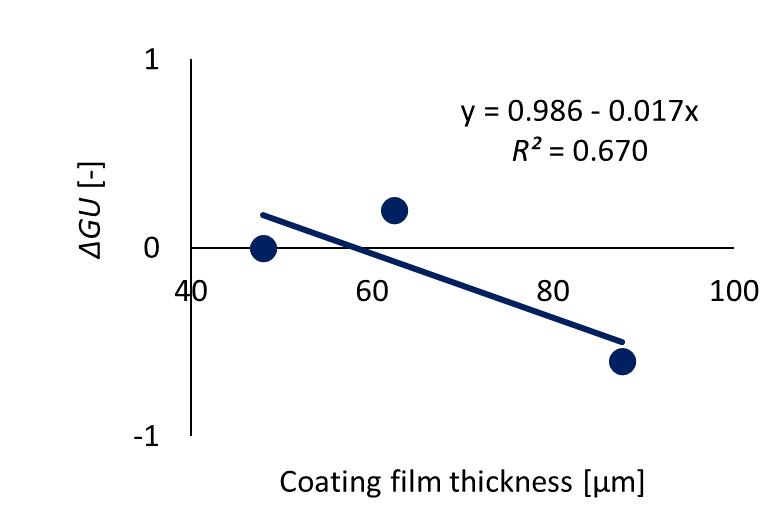
b) e)
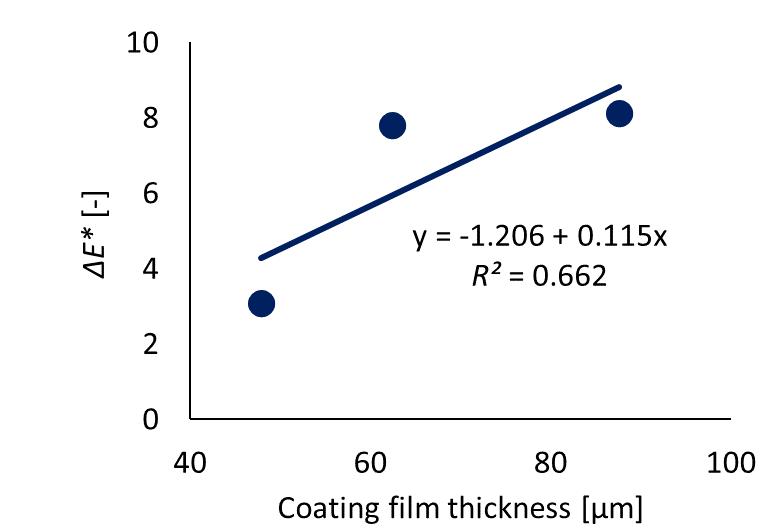
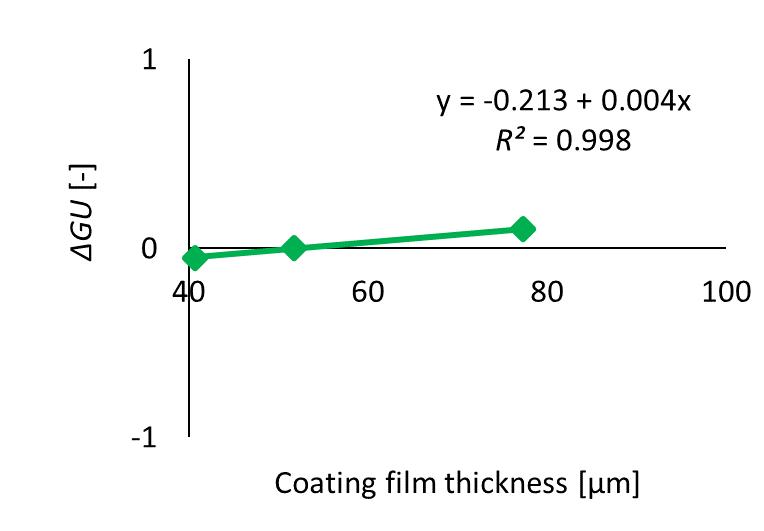
c) f)
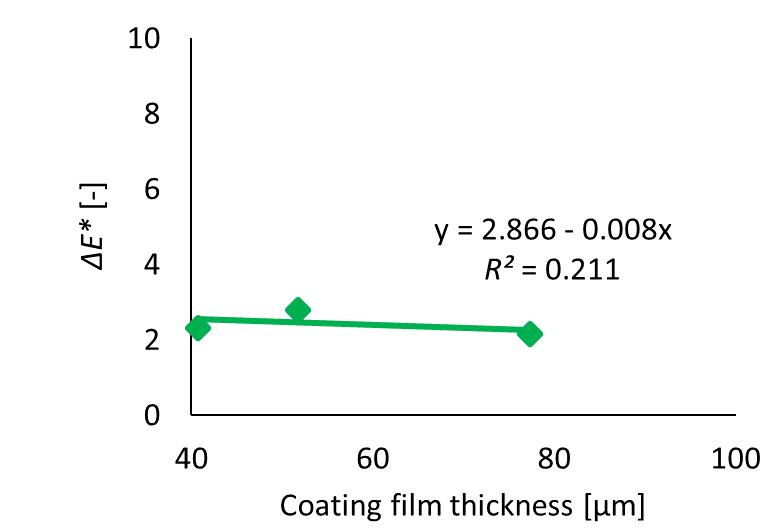
Fig. 2 Dependence of ∆GU, ∆E* on the coating film thickness after 96 hours. Evaluated using correlation analyse and the coefficient of determination R2: a), d) Solvent-based; b), e) Water-based; c), f) Hard wax.
48
The greatest colour difference (Table 9) occurred on Water-based surface finish with two coats (ΔE* = 7.81) and three coats (ΔE* = 8.14) after 96 hours, which was the "High colour difference". Fig. 2d-f show the evaluated dependence of ∆E* on the coating film thickness after 96 hours. The evaluation was done using correlation analyse and the coefficient of determination R2. by For Water-based surface finish, the dependence of ∆E* on the coating film thickness showed “High degree of dependence” (Fig. 2e). For Solventbased surface finish, the dependence of ∆E* on the coating film thickness showed “Very high degree of dependence” (Fig. 2d). For Wax-Oil surface finish, the dependence of ∆E* on the coating film thickness showed “Slight degree of dependence” (Fig. 2f). GURLEYEN (2021) also reports higher colour differences on surface finishes with higher number of coats.
The findings in this research agree with the publications of other authors for native wood surfaces (SALCĂ, and CISMARU 2011; TOLVAJ and MITSUI 2010; PANDELEY 2005). Authors LIU et al. (2019) and TIMAR et al. (2016) used simulated indoor sunlight exposure or other accelerated weathering methods. In these studies, the dependence curves showing the colour change had an initial period of severe increase that was maintained at a practically constant value with further exposure. Though, important changes occurred after short exposure times. However, their further development at longer exposure times cannot be predicted from this measured data, and more research at longer exposure times is needed.
Surface roughness
Statistical evaluation of the impact of individual factors and their interactions (Wood fibre direction and surface finish, Finish products, and Thicknesses of coating film) on the surface roughness (Ra) of lightweight plywood before and after the surface finishing is shown in Table 10.
Tab. 10 Analysis of variance for standard arithmetic deviation of the assessed profile (Ra). Factors Sum of Squares Degrees of Freedom Variance F-test Level of Significanc e p*
Absolute Member
697.76 1 697.76 6512.78 0.000000
Wood fibre direction and Surface finish (WFD-SF)
5.75 3 1.92 17.9 0.000000
Finish products (FP) 0.34 2 0.17 1.61 0.202975
Number of layers (NL) 0.02 2 0.01 0.09 0.912904
WFD-SF * FP 1.43 6 0.24 2.23 0.041628
WFD-SF * NL 0.56 6 0.09 0.87 0.518985
FP * NL 0.60 4 0.15 1.41 0.231688
WFD-SF * FP * NL 0.89 12 0.07 0.69 0.759271
Error 23.14 216 0.11 Note: p* < 0.001 statistically highly significant; p* > 0.05 statistically insignificant
Table 10 shows that the impact of one factor (Wood fibre direction and Surface finish) was statistically highly significant, but the impact of Finish product is statistically insignificant. Among two-factor interactions, only one interaction was statistically low significant. Two-factor interactions were statistically insignificant and three-factor interaction was statistically insignificant too.
Fig. 3 shows that before the surface finishing, the surface roughness of lightweight plywood in the transverse direction was statistically significantly higher than in the longitudinal direction. KÚDELA et al. (2018) and GÁBORÍK et al. (2017) state that the wood
49
surface roughness perpendicular to wood fibre was higher than the roughness parallel to fibre. However, after the surface finishing, regardless of a type of coating material or the thickness of coating film, the roughness in the transverse direction was significantly reduced. NOWROUZI et al. (2021) state that as expected, the surface roughness decreased with the application of coatings. The surface roughness of lightweight plywood after surface finishing was almost the same in the transverse direction as in the longitudinal direction.
As it is seen in Fig. 4, the differences in the surface roughness of lightweight plywood before and after the surface finishing were statistically significant only for Hard wax surface finish with one coat and three coats across the wood fibre. If focused on the average values of roughness, they were significantly lower after surface finishing with one coat than before finishing, especially in the transverse direction.
From the viewpoint of the thickness of coating film, the third coat of Hard wax significantly contributed to the decrease in roughness in the transverse direction. From viewpoint of finish product, the Water-borne material in one coat increased the average roughness in the longitudinal direction, in two coats it slightly increased the roughness in both the longitudinal and transverse directions, and in three coats it slightly reduced the roughness in both directions compared to the unfinished surface. However, these differences in roughness were statistically insignificant.
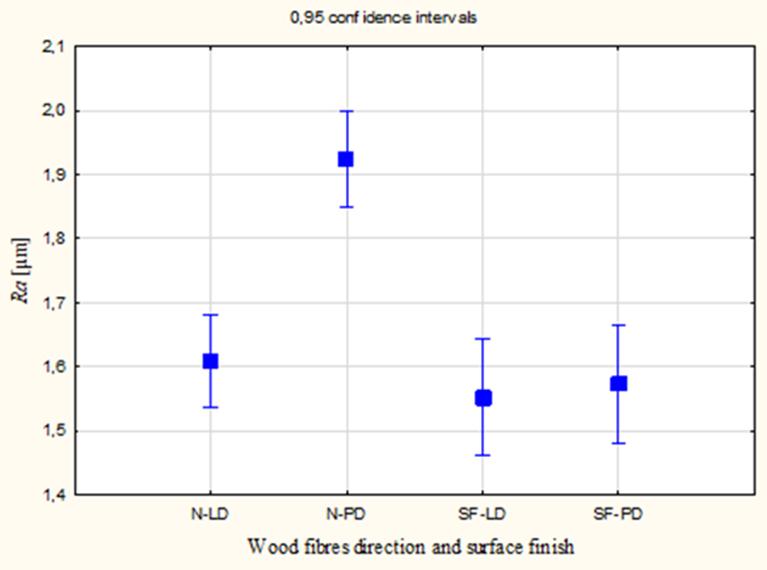
Fig. 3 Dependence of roughness on the surface finish for longitudinal and perpendicular directions. (Note: N - native, SF - surface finish, LD - longitudinal direction, PD - perpendicular direction).
50
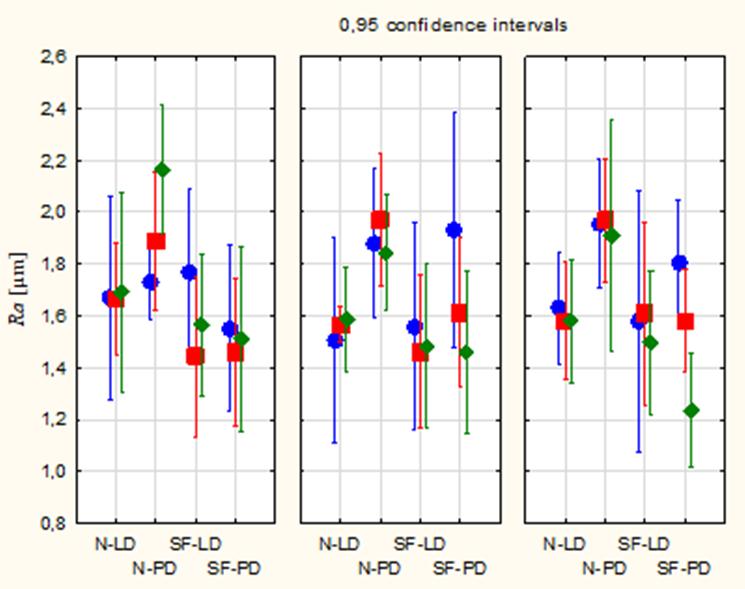
T1 T2 T3
Coating film thickness Solvent-based Water-based Hard wax
Fig. 4 Dependence of roughness on the wood surface finishing for longitudinal and perpendicular direction (three surface finishes, number of layers T1, T2, T3). (Note: N - native, SF - surface finish, LD - longitudinal direction, PD - perpendicular direction).
Solvent-based coating material, when one and two coats were applied, reduced the average surface roughness of lightweight plywood both in the longitudinal and transverse directions. If three coats were applied, the roughness was reduced only in the transverse direction. From the measured values of roughness, it is seen that Hard wax showed the best smoothing actionand thus significantly reduced the surface roughness. An undesirable factor of Water-borne coating materials was also proven, namely the swelling of cut wood fibers which increases the surface roughness. PELOSI et al. (2021) state that the water-based coating penetrates rapidly into wood and the waxy components remain on the surface.
Impact resistance and resistance to abrasion
Table 11 shows the results of the impact resistance of surface finishes. At the highest drop height of 400 mm, the damage, assessed by the naked eye on all surface finishes, was at most of grade 2. (No cracks on the surface and the intrusions were only slightly visible).
This was also confirmed by the visual evaluation using a stereomicroscope LEICA MZ 9.5 with magnification of 17 ×. The sizes of intrusions differed on the individual surface finishes, they were smaller on Hard wax surface finish (Fig. 5) and comparably the same on Solvent-based and Water-based surface finishes. With increasing number of coats, the diameter of intrusion decreased on all three surface finishes. Fig. 6a-c show the dependence of intrusion on the coating film thickness at the impact resistance test at a drop height of 400 mm. The evaluation was done using correlation analyse and the coefficient of determination R2. For Solvent-based and Water-based surface finishes, the dependence of intrusion on the coating film thickness showed “Very high degree of dependence” (Fig. 6a, b) and for Hard wax surface finish the dependence showed “High degree of dependence” (Fig. 6c).
51
Tab. 11 Impact resistance and resistance to abrasion of the surface finishes. Sample Coefficient of the resistance to abrasion KT (Standard deviation) Drop height (mm)
Finish product Number of layers
10 25 50 100 200 400
Ø mm - Degree of change
Solvent-based
T1 0.081 (0.006) 0-1 0-1 0-1 1.2-2 2.3-2 4.3-2 T2 0.097 (0.009) 0-1 0-1 0-1 1.5-2 2.5-2 4.1-2 T3 0.090 (0.007) 0-1 0-1 0-1 0.6-1 2-2 3.7-2
Water-based
Hard wax
T1 0.058 (0.006) 0-1 0-1 0-1 1.5-2 1.9-2 4.2-2 T2 0.057 (0.009) 0-1 0-1 0-1 1.2-1 1.5-2 4.1-2 T3 0.058 (0.006) 0-1 0-1 0-1 1-1 1.3-2 3.6-2 T1 0.040 (0.019) 0-1 0-1 0-1 1.1-1 2.1-2 3.5-2 T2 0.060 (0.012) 0-1 0-1 0-1 1-1 2-2 3-2 T3 0.049 (0.009) 0-1 0-1 0-1 0.9-1 2-2 2.8-2

Fig. 5 The intrusion on Hard wax surface finish with three layers at a drop height of 400 mm.
By comparing the results of impact resistance of the surface finishes with results of other works (CHEUMANI YONA et al. 2021, VIDHOLDOVÁ et al. 2021, SLABEJOVÁ and ŠMIDRIAKOVÁ 2018, SLABEJOVÁ et al. 2018), we can state that representative surface finishes achieved a good impact resistance. CHEUMANI YONA et al. (2021) presents the results of surface finishes of silicate-based formulations on beech wood. On silicate-based surface finishes, the surface damage reached up to grade 3 and the diameters of intrusions were incomparably larger (up to 7.1 mm) than the diameters of intrusions on the surface finishes reported in this paper. The impact resistance of a surface finish is influenced by hardness of the substrate as well as the film's brittleness and elasticity. Impact resistance of the coating increases with increasing thickness of the coating to some extent (SLABEJOVÁ et al. 2018).
52
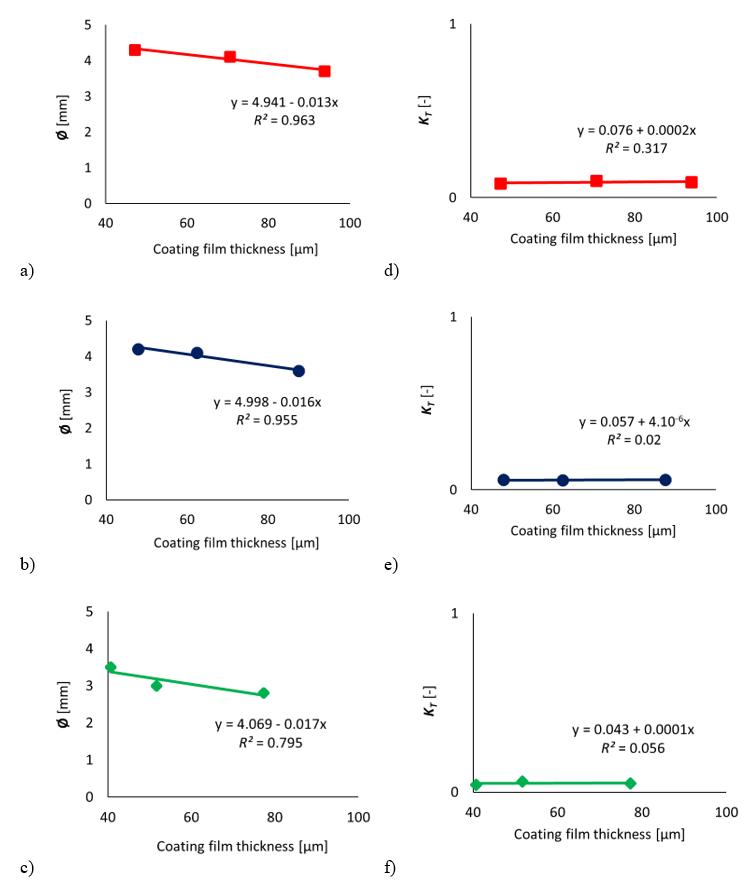
Fig. 6 Dependence of intrusion (at the impact resistance test at a drop height of 400 mm) on the coating film thickness; and dependence of KT factors on the coating film thickness. Evaluated using correlation analyse and the coefficient of determination R2: a), d) Solvent-based; b), e) Water-based; c), f) Hard wax.
Comparing the surface finishes, the lowest coefficient of resistance to abrasion KT was achieved by Hard wax surface finish for all layers (Table 11). It follows that Hard wax showed the best resistance to abrasion. Generally, the resistance to abrasion of all three surface finishes (Fig. 7) was satisfactory when compared with the technical requirements according to the standard STN 91 0102. Fig. 6d-f show the dependence of KT factor on the coating film thickness. The evaluation was done using correlation analyse and the coefficient of determination R2. For Solvent-based surface finish, the dependence of KT factor on the coating film thickness showed “Significant degree of dependence” (Fig. 6d). For Waterbased and Wax-Oil surface finishes, the dependence of KT factor on the coating film thickness showed “Low degree of dependence” (Fig. 6e, f). Comparable results of the
53
coefficient of resistance to abrasion are given in VIDHOLDOVÁ et al. (2021) where Hard wax coating was applied on thermally modified oak wood. The performance of surface systems is highly dependent on coating formulations (PAVLIČ et al. 2021). The resistance to abrasion of Solvent-based, Water-based and Hard wax surface finishes was higher than the resistance of polyester-polyurethane surface finish (SLABEJOVÁ and ŠMIDRIAKOVÁ 2018) and a waterborne UV-hardened surface finish (TESAŘOVÁ et. al. 2010).

a) b) c) Fig. 7 Resistance to abrasion of the surface finishes: a) Solvent-based T3; b) Water-based T3; c) Hard wax T3 (Note: T3 – three layers.).
Statistically significant relationship was found between higher resistance of flooring systems to impact stress and an improved abrasion resistance (PAVLIČ et al. 2021). This conclusion was also confirmed by our results. The Hard wax surface finish achieved the best impact resistance (the smallest intrusions) and the lowest coefficient of resistance to abrasion.
CONCLUSION
Three surface finishes: Solvent-based, Water-based and Hard wax, were applied on lightweight plywood to study their performances (gloss value, colour difference, surface roughness, impact resistance, abrasion resistance). The properties were evaluated from the viewpoint of their dependence on type of the coating material and of the coating film thickness (number of layers). The gloss value, colour difference, surface roughness, impact resistance, and abrasion resistance were dependent on the type of coating material. The gloss value, colour difference and impact resistance were also depended on the coating film thickness. Evaluated dependences of gloss value, colour difference, and impact resistance on the coating film thickness of the surface finishes showed high degree of dependence. These were lower on Hard wax surface finish than on Solvent-based and Water-based surface finishes. The surface roughness was depended also on the wood fibre direction. When selecting a surface finish to be applied on lightweight plywood, it is important to consider the mechanical properties together with the resistance properties of the surface finish in terms of the use of lightweight plywood in furniture or interior.
REFERENCES
AYATA, U.; GURLEYEN, L.; ESTEVES, B.; CAKICIER, N. 2017. Effect of heat treatment (ThermoWood) on some surface properties of parquet beech (Fagus orientalis Lipsky.) with different layers of UV system applied. In BioResources, 12, 3876–3889.
54
BEKHTA, P., SALCA, E.A., AUREL LUNGULEASA, A. 2020. Some properties of plywood panels manufactured from combinations of thermally densified and non-densified veneers of different thicknesses in one structure. In Journal of Building Engineering. 29, ISSN 2352-7102. DOI: 10.1016/j.jobe.2019.101116 BEKHTA,P.,KRYSTOFIAK,T.,PROSZYK,S.,LIS,B. 2018. Surface gloss of lacquered medium density fibreboard panels veneered with thermally compressed birch wood. In Progress in Organic Coatings, 117, 10−19, ISSN 0300-9440. DOI: 10.1016/j.porgcoat.2017.12.020 BEKHTA, P., MAMOŇOVÁ, M., SEDLIAČIK, J., NOVÁK, I. 2016. Anatomical study of short-term thermo-mechanically densified alder wood veneer with low moisture content. In European Journal of Wood and Wood Products, 1–10. BUDAKCI, M. 1997. Effects of the Resistance to Adhesion Surface of Layer Thickness Glossy and Hardness at the Wood’s Varnishes. In Master’s Thesis, Gazi University, Institute of Science and Technology, Ankara, Turkey. CIVIDINI, R., TRAVAN, L., ALLEGRETTI, O. 2007. White beech: A tricky problem in drying process. In International Scientific Conference on Hardwood Processing, Quebec City, Canada. FEKIAČ, J., SVOREŇ, J., GÁBORÍK, J., NĚMEC, M. 2022. Reducing the Energy Consumption of Circular Saws in the Cutting Process of Plywood. In Coatings, 12(1):55. DOI: 10.3390/coatings12010055 FEKIAČ, J., GÁBORÍK, J., ŠMIDRIAKOVÁ, M. 2020. 3D-formability of perforated materials based on veneer. In Acta Facultatis Xylologiae Zvolen, 62(1):55−65. DOI: 10.17423/afx.2020.62.1.05 FEKIAČ, J., GÁBORÍK, J. 2018. Influence of veneer perforation on 2D formability of two-layer material. In Ann. WULS-SGGW, For. and Wood Technol., 104: 53−59. FEKIAČ, J., ZEMIAR, J., GAFF, M., GÁBORÍK, J., GAŠPARÍK, M., MARUŠÁK, R.2015. 3D-Moldability of Veneers Plasticized with Water and Ammonia. In BioResources, 10(1): 866−876. GARAY, R., INOSTROZA, M., DUCAUD, A. 2017. Color and gloss evaluation in decorative stain applied to cases of Pinus radiata wood treated with copper azole micronized Type C. In Maderas. Ciencia y tecnología, 19(1), ISSN 0718-221X. DOI: 10.4067/S0718-221X2017005000003 GURAU, L. 2013. Analysis of Roughness of Sanded Oak and Beech Surfaces. In Pro Ligno, 9(4): 741–750, ISSN 2069-7430. GURAU, L., IRLE, M. 2017. Surface Roughness Evaluation Methods for Wood Products: a Review. In Curr Forestry Rep 3, 119–131. DOI: 10.1007/s40725-017-0053-4 GURLEYEN, L.; AYATA, U.; ESTEVES, B.; GURLEYEN, T.; CAKICIER, N. 2019. Effects of thermal modification of oak wood upon selected properties of coating systems. In BioResources, 14, 1838–1849. GURLEYEN, L. 2021. Effects of Artificial Weathering on the Color, Gloss, Adhesion, and Pendulum Hardness of UV System Parquet Varnish Applied to Doussie (Afzelia africana) Wood. In BioResources, 16(1), 1616−1627. GÁBORÍK, J., GAFF, M., RUMAN, D., ŠOMŠÁK, M., GAFFOVÁ, Z., SVOBODA, T., VOKATY, V., SÍKORA,A. 2017. The influence of thermomechanical smoothing on beech wood surface roughness. In BioResources, 12(1): 448−456. HSU, F. Y., HUNG, K. C., XU, J. W., WU, T. L., WU, J. H. 2021. Physicomechanical properties and creep behavior of plywood composed of fully and partially heat-treated veneers. In Wood Sci Technol 55, 445–460. DOI: 10.1007/s00226-020-01250-w CHANG,C.W.,LEE,H.L.,LU,K.T. 2019. Manufacture and Characteristics of Oil-Modified Refined Lacquer for Wood Coatings. In Coatings. 9(1):11. DOI: 10.3390/coatings9010011 CHEUMANI YONA, A. M., JURE ŽIGON, SEBASTIAN DAHLE, J. Ž., PETRIČ, M. 2021. Study of the Adhesion of Silicate-Based Coating Formulations on a Wood Substrate. In Coatings 11(1):61. DOI: 10.3390/coatings11010061 ISO 7724-3. Paints and Varnishes—Colorimetry—Part 3: Calculation of Colour Differences; International Organization for Standardization: Geneva, Switzerland, 1984. KRÁL, P., HRÁZKY, J. 2005. Kompozitní materiály na bázi dřeva.2. Část: Mendelova Zemědělská a Lesnická univerzita v Brně, 154 p. ISBN 80-7157-878-9.
55
KRŽIŠNIK, D., LESAR, B., THALER, N., HUMAR, M. 2018. Influence of Natural and Artificial Weathering on the Colour Change of Different Wood and Wood-Based Materials. In Forests, 9(8):488. DOI: 10.3390/f9080488 KÚDELA, J., SIKORA, A., SVOCÁK, J. 2020. Colour stability of spruce wood surface coated with a polyurethane lacquer without and with a UV absorber admixture. In XIII. Konference pigmenty a pojiva: sbornik / conference preceedings. Pardubice: Chemagazín, 28-30. ISBN 978-80-906269-5-9. KÚDELA, J., MRENICA, L., JAVOREK, Ľ. 2018. The Influence of Milling and Sanding on Wood Surface Morphology. In Acta Facultatis Xylologiae Zvolen, 60(1): 71−83. DOI: 10.17423/afx.2018.60.1.08 KÚDELA, J., JAVOREK, Ľ., MRENICA, L. 2016a. Influence of milling and sanding on beech wood surface properties. Part I. Surface morphology. In Ann. WULS-SGGW, For. and Wood Technol., 95: 148−153. KÚDELA, J., ŠTRBOVÁ, M., JAŠ, F. 2016b. Influence of accelerated ageing on colour and gloss changes in tree of heaven surface treated with an iruxil coating system. In Acta Facultatis Xylologiae, 58(1): 25−34. LAINA, R., SANZ-LOBERA, A., VILLASANTE, A., LÓPEZ-ESPÍ, P., MARTÍNEZ-ROJAS, J. A., ALPUENTE,J.,SÁNCHEZ-MONTERO,R.,VIGNOTE,S. 2017. Effect of the anatomical structure, wood properties and machining conditions on surface roughness of wood. In Maderas. Ciencia y tecnología. 19(2). DOI: 10.4067/S0718-221X2017005000018 LANGOVÁ, N., JOŠČÁK, P. 2014. Effect of mechanical modification of wood veneers on their planar formability. In Ann. WULS-SGGW, For. and Wood Technol., (87): 142–147. ISSN 1898-5912. LIU, R.; ZHU, H.; LI, K.; YANG, Z. 2019. Comparison on the aging of woods exposed to natural sunlight and artificial Xenon light. In Polymers, 11, 709. LUO,B.,ZHANG,J.,BAO,X.,LIU,H.,LI,L. 2020. The effect of granularity on surface roughness and contact angle in wood sanding process. In Measurement. 165. ISSN 0263−2241. DOI: 10.1016/j.measurement.2020.108133 NOWROUZI,Z.,MOHEBBY,B.,PETRIC,M.,EBRAHIMI,M. 2021. Influence of nanoparticles and olive leaf extract in polyacrylate coating on the weathering performance of thermally modified wood. In European Journal of wood and wood products. DOI: 10.1007/s00107-021-01761-8 PANDELEY, K.K. 2005. Study of the effect of photo-irradiation on the surface chemistry of wood. In Polym. Degrad. Stab., 90, 9–20. PAVLIČ,M.,PETRIČ,M.,ŽIGON,J. 2021. Interactions of Coating and Wood Flooring Surface System Properties. In Coatings, 11(1):91. DOI: 10.3390/coatings11010091.
PELOSI, C., RUBINO, G., CAPOBIANCO, G., LANTERI, L., AGRESTI, G., BONIFAZI, G., SERRANTI, S., PICCHIO,R.,LO MONACO,A. 2021 A Multi-Technique Approach to Evaluate the Surface Properties of Heat-Treated Chestnut Wood Finished with a Water-Based Coating. In Coatings, 11, 6, 706. DOI: 10.3390/coatings11060706 SALCĂ, E.A., CISMARU, I. 2011. Colour changes evaluation of freshly cut alder veneers under the influence of indoor sunlight. Pro Ligno, 7, 15–24. SALCA E. A., BEKHTA, P., SEBLII, Y. 2020. The Effect of Veneer Densification Temperature and Wood Species on the Plywood Properties Made from Alternate Layers of Densified and NonDensified Veneers. In Forests. 11(6):700. DOI: 10.3390/f11060700. SCRINZI, E., ROSSI, S., DEFLORIAN, F., ZANELLA, C. 2011. Evaluation of aesthetic durability of waterborne polyurethane coatings applied on wood for interior applications. In Progress in Organic Coatings, 72(1-2), 81-87. ŞENOL, S., BUDAKÇI, M. 2019. Effect of Thermo-Vibro-Mechanic® Densification Process on the Gloss and Hardness Values of Some Wood Materials. In BioResources, 14(4), 9611−9627. SLABEJOVÁ, G., ŠMIDRIAKOVÁ, M. 2014. Influence of modification of veneers on 3D - forming. In Annals of Warsaw University of Life Sciences. Forestry and Wood Technology, (85): 226–229. ISSN 1898-5912. SLABEJOVÁ G.,ŠMIDRIAKOVÁ M.,PÁNIS D.2018. Quality of silicone coating on the veneer surfaces. In Bioresource 13, 776−788. DOI: 10.15376/biores.13.1.776–788 SLABEJOVÁ G.,ŠMIDRIAKOVÁ M.2018. Quality of pigmented gloss and matte surface finish. In Acta Fac Xylologiae Zvolen, 60, 105−113. DOI: 10.17423/afx.2018.60.2.10
56
SLABEJOVÁ, G., ŠMIDRIAKOVÁ, M. 2020. Colour of thermally modified wood finished with transparent coatings. In Trieskové a beztrieskové obrábanie dreva (Chip and Chipless Woodworking Processes), 12, 97–102. SLABEJOVÁ G., ŠMIDRIAKOVÁ M. 2021. Colour stability of surface finishes on thermally modified beech wood. In Ann. WULS-SGGW, For. and Wood Technol., 114: 116−124. STN EN ISO 2813: Paints and varnishes. Determination of gloss value at 20 degrees, 60 degrees and 85 degrees. Slovak Office of Standards, Metrology and Testing: Bratislava, Slovakia, 2016. STN EN ISO 16474-1: Paints and varnishes - Methods of exposure to laboratory light sources - Part 1: General guidance. Slovak Office of Standards, Metrology and Testing: Bratislava, Slovakia, 2014. STN EN ISO 16474-2: Paints and varnishes - Methods of exposure to laboratory light sources - Part 2: Xenon-arc lamps. Slovak Office of Standards, Metrology and Testing: Bratislava, Slovakia, 2014. STN EN ISO 7784-3: Paints and varnishes - Determination of resistance to abrasion - Part 3: Method with abrasive-paper covered wheel and linearly reciprocating test specimen. Slovak Office of Standards, Metrology and Testing: Bratislava, Slovakia, 2016. STN EN ISO 6272-2: Paints and varnishes - Rapid-deformation (impact resistance) tests - Part 2: Falling-weight test, small-area indenter. Slovak Office of Standards, Metrology and Testing: Bratislava, Slovakia, 2012. STN 91 0102: Furniture. Surface Finishing of Wooden Furniture. Technical Requirements; Slovak Office of Standards, Metrology and Testing: Bratislava, Slovakia, 1991. TESAŘOVÁ D., CHLADIL J., ČECH P., TOBIÁŠOVÁ K. 2010. Ekologické povrchové úpravy. Mendelova univerzita v Brně: Brno, Czech republic, 126 p. TIMAR,M.C.,VARODI,A.M.,GURĂU,L. 2016. Comparative study of photodegradation of six wood species after short-time UV exposure. In Wood Sci. Technol. 2016, 50, 135–163. TOLVAJ, L., MITSUI, K. 2010. Correlation between hue angle and lightness of light irradiated wood. In Polym. Degrad. Stab., 95, 638–642. VIDHOLDOVÁ,Z,SLABEJOVÁ,G. 2021. Colour Stabilisation of Surface of Four Thermally Modified Woods with Saturated Water Vapour by Finishes. In Polymers, 13(19):3373. DOI: 10.3390/polym13193373 VIDHOLDOVÁ Z, SLABEJOVÁ G, ŠMIDRIAKOVÁ M. 2021. Quality of Oil- and Wax-Based Surface Finishes on Thermally Modified Oak Wood. In Coatings. 11(2):143. DOI: 10.3390/coatings11020143 YANG, F., ZENG, J., LONG, H., XIAO, J., LUO, Y., GU, J., ZHOU, W., WEI, Y., DONG, X. 2020. Micrometer Copper-Zinc Alloy Particles-Reinforced Wood Plastic Composites with High Gloss and Antibacterial Properties for 3D Printing. In Polymers, 12(3):621. DOI: 10.3390/polym12030621 ZEMIAR, J., FEKIAČ, J., GÁBORÍK, J. 2014. Strengthening of veneers for 3D-forming. In Annals of Warsaw University of Life Sciences. Forestry and Wood Technology. 2014. (88): 297–303. ISSN 1898-5912.
ACKNOWLEDGEMENTS
This work was supported by the Scientific Grant Agency of the Ministry of Education SR Grant VEGA 1/0556/19. This publication is also the result of the project implementation: Progressive research of performance properties of wood-based materials and products (LignoPro), ITMS: 313011T720 (20 %) supported by the Operational Programme Integrated Infrastructure (OPII) funded by the ERDF.
ADDRESSES OF AUTHOR
Ing. Gabriela Slabejová, PhD. Ing. Mária Šmidriaková, PhD.
57
Department of Furniture and Wood Products Faculty of Wood Sciences and Technology Technical University in Zvolen T. G. Masaryka 24, 960 01 Zvolen Slovak Republic mail: slabejova@tuzvo.sk, smidriakova@tuzvo.sk
58









